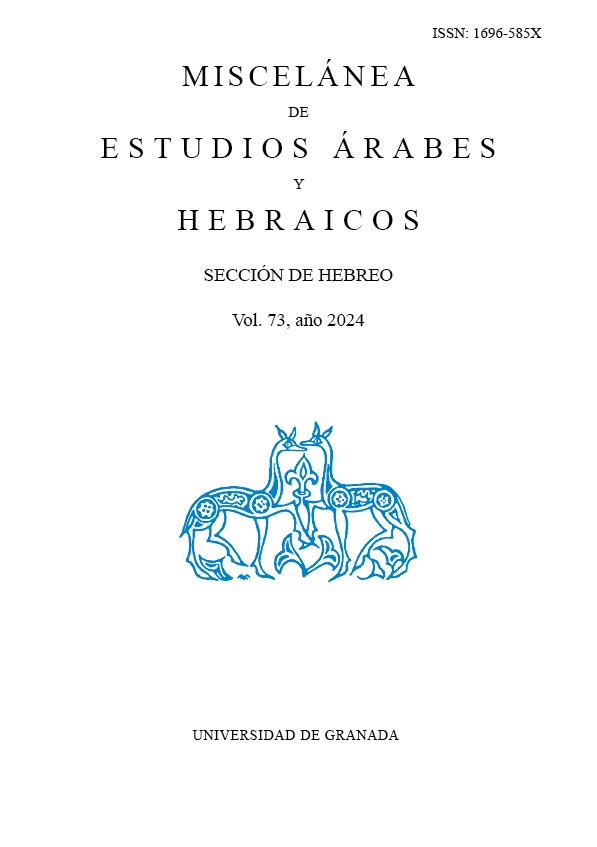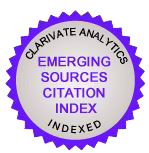Interpretative Techniques in Rabbinic Literature: Theoretical Foundations of Research and New Approaches
DOI:
https://doi.org/10.30827/meahhebreo.v73.30989Keywords:
Rabbinic literature, Rabbinic interpretation, Philosophical Hermeneutics, Theory of Text, Theory of InterpretationAbstract
In this paper I present a fresh hermeneutical orientation for the study of rabbinic interpretative techniques. The proposal is based on the one hand, on the theoretical advances of 20th century philosophical hermeneutics in relation to dealing with texts (mainly in the works of Hans Georg Gadamer and Paul Ricoeur), and, on the other hand, on a critical review of the status questionis in rabbinic interpretation studies. A methodological application of this hermeneutical orientation is suggested, in the form of a hermeneutical-philological analysis of rabbinic texts focusing on the concrete application of rabbinic interpretative techniques; some guidelines for its development are offered.
Downloads
References
Almog, S. (2003), «One Young and The Other Old» – Halakhah and Aggadah as Law and Story. Canadian Journal of Law and Society, 18/2: 27-43.
Atzmon, A. (2012), «The Same Fate Is in Store for the Righteous and the Wicked»: Form and Content in Midreshei Aggadah. Journal for the Study of Judaism, 43: 58-77.
Bakhos, C. (ed.) (2006), Current Trends in the Study of Midrash. Boston: Brill.
Berrocal Fonseca, B. (2024), Técnicas interpretativas de la literatura rabínica. Revisión crítica desde la hermenéutica contemporánea [Tesis Doctoral]. Madrid: Universidad Complutense de Madrid.
Berrocal Fonseca, B. (2023), La centralidad del texto en el universo rabínico. Una lectura desde la hermenéutica posmoderna. En R. A. Barroso Romero, J. A. Castillo Lozano et. al. (eds), La diversidad de experiencias en las religiones. Ritos, textos y pensamiento. Madrid: Teseo Press.
Bonsirven, J. (1939), Exégèse rabbinic et exégèse paulinniene. París: Beauchesne et ses Fils.
Boyarin, D. (1994), Intertextuality and the Reading of Midrash. Bloomington: Indiana University Press.
Brewer, D.I. (1992), Techniques and Assumptions in Jewish Exegesis before 70 C.E. Tubinga: Mohr Siebeck.
Chernick, M. (2013), Subversive Aggadah: The Demonition of Imagination and Narrative in the History of Halakhic Development. University of Toronto Journal of Jewish Studies, 4:1-19.
Chernick, M. (1990), Internal Restrains on Gezerah Shawa’s Application. Jewish Quarterly Review, 80: 253-282.
Elon, M. (1994), Exegetical Interpretation of the Torah. En Jewish Law; History, Sources, Principles. Vol I. Filadelfia: The Jewish Publication Society.
Fishbane, M. (ed.) (1993), The Midrashic Imagination. Jewish Exegesis, Thought, and History. Nueva York: State University of New York Press.
Fishbane, M. (1986), Inner Biblical Exegesis: Types and Strategies of Interpretation in Ancient Israel. En G. H. Hartman - S. Budick (ed.), Midrash and Literature. New Haven: Yale University Press.
Fraade, S. D. (1999), Literary Composition and Oral Performance in Early Midrashim. Oral Tradition, 14: 33-51.
Gadamer, H. G. (2005), Verdad y Método. Sígueme: Salamanca.
Gadamer, H. G. (2004), Verdad y Método II. Sígueme: Salamanca.
Goldin, J. (1988), The Freedom and Restraint of Haggadah. En Eichler, B. L. – Tigay, J. H. (eds.), Studies in Midrash and Related Literature. Filadelfia: The Jewish Publication Society.
Gruenwald, I. (1993), Midrash and the «Midrashic Condition»: Preliminary Considerations. En M. Fishbane (ed.), The Midrashic Imagination. Jewish Exegesis, Thought, and History. Nueva York: State University of New York Press.
Guttmann, A. (1950) «Foundations of Rabbinic Judaism». Hebrew Union College Annual: 453-473
Halivni, D. W. (2013), The Formation of the Babylonian Talmud. Oxford: Oxford University Press.
Handelman, S (1982)., The Slayers of Moses: The Emergence of Rabbinic Interpretation in Modern Literary Theory. Nueva York: State University of New York Press.
Hartman, G. H. - Budick, S. (eds.) (1986), Midrash and Literature. New Haven: Yale University Press.
Heinemann, J. (1986), The Nature of the Aggadah. En Hartman, G. H. - Budick, S. (eds.), Midrash and Literature. New Haven: Yale University Press.
Hezser, C. (2017), Bookish Circles? The Use of Written Texts in Rabbinic Oral Culture. Temas Medievales 25: 63-81.
Irigaray, L. (1999), Entre Orient et Occident. París: Grasset.
Jaffee, M. S. (2007), Rabbinic Authorship as a Collective Enterprise. En Fonrobert, C. E. – Jaffee, M. S. (eds.), The Cambridge Companion to the Talmud and Rabbinic Literature. Nueva York: Cambridge University Press.
Jaffee, M. S. (1999), Oral Tradition in the Writings of Rabbinic Oral Torah: on Theorizing Rabbinic Orality. Oral Tradition, 14: 3-32.
Levinson, J. (2005), The Cultural Dignity of Narrative. En Rubenstein, J. L. (ed.), Creation and Composition, The Contribution of the Bavli Redactors (Stammaim) to the Aggada, Tubinga.
Martín-Contreras, E. (2012), The Phenomenon Qere We La’ Ketib in the Main Biblical Codices: New Data. Vetus Testamentum, 62: 77-87
Martín-Contreras, E. (2005), El principio hermenéutico ’en ketib ka’n ’el·la’ en la Mekilta de Rabbi Yismael. Sefarad, 65/1:85-102
Martín-Contreras, E. (2003), Rethinking Hermeneutical Techniques: Suggestions from their Practice. Henoch, XXV: 79-92.
Martín-Contreras, E. (2002a), La interpretación de la creación. Estella: Verbo Divino.
Martín-Contreras, E. (2002b), El contexto como factor restrictivo. Miscelánea de Estudios Árabes y Hebraicos, Sección Hebreo, 51: 21-33.
Martín-Contreras, E. (2000), ’En…’el·la‘ en la exegesis de Génesis Rabbah. Cuadernos ’Ilu 3: 147-157.
Martín-Contreras, E. - Miralles Maciá, L. (2014), Interdisciplinary Perspectives for the Study of the Text of the Hebrew Bible: Open Questions. Journal of Ancient Judaism, Supplements, 13: 17-36.
Metzger, D. - Katz, S. B. (2010), The «Place» of Rhetoric in Aggadic Midrash. College English, 72/6: 638-651.
Mielziner, M. (1925), Introduction to Talmud. Nueva York: Bloch Publishing Company.
Mulder, J. (1988), The Transmission of the Biblical Text. En Miqra: Text, Translation, Reading and Interpretation of the Hebrew Bible. Filadelfia: Fortress Press.
Navarro Peiró, M. A. (1988), Las treinta y tres reglas de interpretación según el texto del Génesis ha-Gadol. Estudios Bíblicos, 46: 79-96.
Navarro Peiró, M. A. (1987), Las treinta y tres reglas de interpretación según el texto de la Misná de Rabbi Eliezer. Miscelánea de Estudios Árabes y Hebreos, 36: 55-72.
Neusner, J. (1999), Introduction to Rabbinic Literature. Nueva York: Yale University Press.
Neusner, J. (1994), The Midrash. An Introduction. Nueva Jersey: Jason Aaronson.
Neusner, J. (1988), Midrash in Context. Exegesis in Formative Judaism. Filadelfia: Scholars Press.
Pérez Fernández, M. (1992), Tipología exegética en los tannaítas. Miscelánea de Estudios Árabes y Hebraicos, 41/2: 53-62.
Ricoeur, P. (2000), Del texto a la acción. Ensayos de hermenéutica II. Buenos Aires: Fondo de Cultura Económica.
Ricoeur, P. (1995), Teoría de la interpretación. Discurso y excedente de sentido. Ciudad de México: Siglo XXI.
Rosenweig, B. (1972), The Hermeneutic Principles and their Application. Tradition, 13: 49-76
Rubenstein, J. L. (ed.) (2005a), Creation and Composition. The Contribution of the Bavli Redactors (Stammaim) to the Aggada. Tubinga: Mohr Siebeck.
Rubenstein, J. L. (2005b), Criteria of Stammaitic Intervention in Aggada. En Rubenstein, J. L. (ed.), Creation and Composition. The Contribution of the Bavli Redactors (Stammaim) to the Aggada. Tubinga: Mohr Siebeck.
Samely, A. (2007), Forms of Rabbinic Literature and Thought. Oxford: Oxford University Press.
Samely, A. (2002), Rabbinic Interpretation of the Scripture in the Mishnah. Oxford: Oxford University Press.
Samely, A. (1995), Stressing Scripture’s Words: Semantic Contrast as a Midrashic Technique in the Mishnah. Journal of Jewish Studies, 46: 196-229.
Samely, A. (1994), Justifying Midrash: On an ‘Intertextual’ Interpretation of Rabbinic Interpretation. Journal of Semitic Studies, 39,1: 19-32
Samely, A. (1991), Between Scripture and its Rewording: Towards a Classification of Rabbinic Exegesis. Journal of Jewish Studies, 42: 39-67.
Sanders, J. A. (1979), Text and Canon: Concepts and Method. Journal of Biblical Literature, 98: 5-29.
Shanks Alexander, E. (2007), The Orality of Rabbinic Writing. En Fonrobert, C. E. – Jaffee, M. S. (eds.), The Cambridge Companion to the Talmud and Rabbinic Literature. Nueva York: Cambridge University Press.
Steinmetz, D. (2005), Agada Unbound. Inter-Agadic Characterization of Sages in the Bavli and Implications for Reading Agada. En Rubenstein, J. L. (ed.), Creation and Composition. The Contribution of the Bavli Redactors (Stammaim) to the Aggada. Tubinga: Mohr Siebeck.
Strack, H. L. - Stemberger, G. (1996), Introducción a la Literatura Talmúdica y Midrásica. Pamplona: Verbo Divino.
Towner, S. (1982), Hermeneutical Systems of Hillel and the Tannaim: A Fresh Look. Hebrew Union College Annual, 53: 101-135.
Vegas Montaner, L. (trad.) (1994), Génesis Rabbah I (Génesis 1-11). Estella: Verbo Divino.
Yadin, A., 2006, Resistance to Midrash? Midrash and Halakhah in the Halakhik Midrashim. En Bakhos, C. (ed.), Current Trends in the Study of Midrash. Boston: Brill.
Zeitlin, S. (1963), Hillel and the Hermeneutic Rules. Jewish Quarterly Review, 54: 161-173.
Published
How to Cite
Issue
Section
License
Copyright (c) 2024 Bárbara Berrocal Fonseca

This work is licensed under a Creative Commons Attribution-NonCommercial 4.0 International License.

Este obra está bajo una licencia de Creative Commons Reconocimiento-NoComercial 4.0 Internacional.












